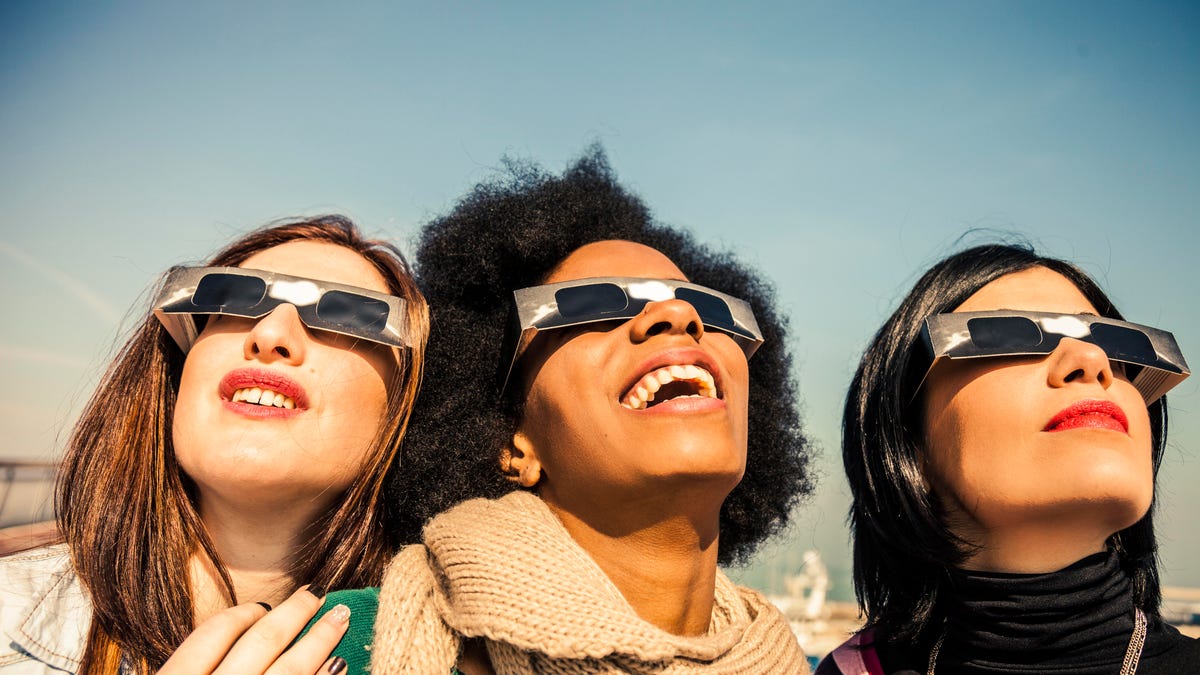Annular Solar Eclipse Eye Safety: What an Optometrist Wants You to Know

There’s an annular solar eclipse on Oct. 14 (Saturday) that will be visible. According to NASA, it will start in Oregon and end a few hours later in Texas, also hitting Nevada, Utah and New Mexico, along with parts of California, Idaho, Colorado and Arizona. It’ll also hit parts of Central and South America.
An annular solar eclipse happens when the moon squeezes between the sun and the Earth, but at a distance that leaves the sun only partially covered, resulting in a cool “ring of fire” look. And while you probably already know it’s important to wear eye protection during one of these, it bears repeating. According to Dr. Ronald Benner, president of the American Optometric Association, unsafe viewing of a solar eclipse can cause solar retinopathy, which is a type of retinal damage he compared to sunburn on the “satellite dish of the eye.” Failing to wear proper eye protection will let in a dangerous amount of ultraviolet radiation and damage the macular tissue in the retina.
“Once it’s burned and scarred, it’s a bad thing,” Benner said.
Here’s how a solar eclipse could damage your eyes, how to view it safely and tips for finding the right glasses.
This NASA photo shows an annular solar eclipse photographed in 2012.
Solar retinopathy: What happens to your eyes if you look at a solar eclipse?
Put simply, solar retinopathy is damage to the retina. Benner said the damage usually takes about six to 12 hours to show up. Common symptoms include blurry vision, blind spots, distorted color vision or otherwise warped vision.
If you notice these symptoms, you should see a doctor right away to pinpoint the source of your vision problems. But according to the American Academy of Ophthalmology, there is “no known beneficial treatment” for the condition, only prevention.
Many patients will regain normal vision acuity within a few months, though it may be random. But Benner adds that recovery may take up to six months or a year, and that sometimes people don’t fully recover and their vision acuity is affected from then on.
Is there anyone who might be more susceptible to solar retinopathy? No, Benner said.
“Every individual is a unique individual,” Benner said, but no one’s immune to damage when it comes to the delicate parts of the eye. In other words, don’t think you’ll be safe to steal a peak because you don’t sunburn often.
“When it comes to the retinal tissue, it’s so much different,” he said.
There’s also no specific amount of time that you can look at the sun before you’re at risk of retinal damage. According to the Australian Radiation Protection and Nuclear Safety Agency, even a few seconds can cause permanent harm.
How to find solar eclipse glasses and avoid fakes
Now that the worst-case scenario is out of the way, let’s move on to how to actually protect your eyes during a solar eclipse. And no, sunglasses won’t cut it. Proper solar viewers or eclipse glasses are thousands of times darker than sunglasses, according to NASA.
Both the American Optometric Association and the American Academy of Ophthalmology say to look for glasses that have been given the OK by the American Astronomical Society. The AAS includes glasses that meet the International Organization for Standardization (ISO) 12312-2 standard. Importantly, the AAS notes that counterfeit glasses or those that don’t meet safety standards can also claim this or use it as a logo — so stick to the list of safer sellers and don’t rely only on looking for that number.
There’s a very long list, but some brands/sellers recommended by the AAS are:
Some Walmart, Lowes and Home Depot locations sell glasses in-store that meet safety standards, the AAS says, but it can’t
guarantee that the glasses sold online by these stores are also legitimate, because they may use a different seller for online products. It’s worth swinging by one of these stores to see what they have in stock if you’re looking for glasses at the last minute.
One more way to get safe glasses: You may be able to pick up a free pair at your local library, using this interactive map of participating libraries, which the AAS provided.
You won’t see sites like Amazon in the AAS’ recommendations, and there’s a reason for that: improperly tested glasses have been sold on the platform in the past. If you do go this route, the AAS recommends making sure the seller is “identified on the site” and “listed on this page.” One AAS-approved glasses seller that offers products on Amazon is Soluna, which links out to Amazon pages directly. (Use this link for a $10 2-pack, this one for a $15 5-pack or this one for a $20 10-pack, provided directly by Soluna itself.) However, do keep in mind the AAS warning about marketplaces like Amazon and eBay, and consider giving them an extra test prior to any eclipse activity (see below).
How to check your solar eclipse glasses
Even if you’ve done all the right things by referencing the AAS website to find the right glasses or viewers, it’s a good idea to give them a test run before the main event.
You can do this by putting your glasses on and wearing them around other sources of light, like street lights or car lights. According to the American Academy of Ophthalmology, you shouldn’t be able to see any light in your eclipse glasses, besides the sun or sunlight reflected in a mirror. If light comes through, Benner said, “they’re not good.”
For parents of younger kids, Benner has an extra word of caution: Watch them closely with their glasses, or just keep them in the house to watch it on TV.
Us adults know better than to risk looking at the sun, but children may not.
Source: CNET















